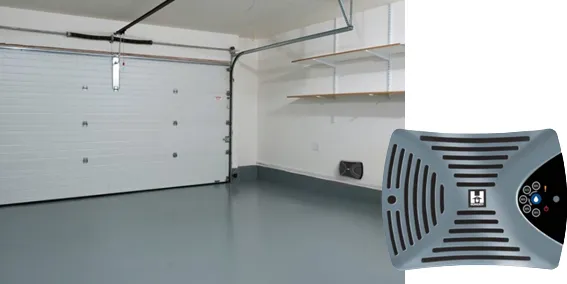You open the door from your home into the garage. It’s time for a bit of early morning yoga. As always, the cool, damp air hits you in the face. The musty smell, the beads of moisture around the windows – you’ve definitely got some humidity going on.
However, isn’t that normal for a garage? Well, yes and no. It’s normal for a garage that hasn’t been properly insulated and protected. It’s not normal for a garage where you want to protect your precious possessions or even be comfortable during DIY activities or a morning workout.

There are many reasons that your garage might have a lot of moisture, but it doesn’t have to mean creating an uncomfortable or dangerous situation. In this guide, we’ll walk you through what you need to know about humidity and how to prevent it throughout the year.
Where’s It Coming From?
First, let’s consider where the moisture might be coming from. One answer is simple enough. It’s coming from the environment outside. Maybe you live in a humid area of the country, like the Southeast or the Northeast. Perhaps the ocean is nearby, or maybe a sizeable lake. In these cases, it stems from the environment in which you live. However, there are other possible reasons for moisture to be hanging out in the garage, including the following:
- Your garage is lacking insulation.
- Your garage isn’t weathertight.
- You keep green firewood in the garage (greenwood contains a lot of moisture that enters the environment).
- You have your washer and dryer in the garage – the dryer’s exhaust vent can vent moisture into the garage.
- You have liquids stored in the garage in containers that aren’t airtight.
- You have an epoxy‑sealed garage floor.
- You use cardboard boxes to store your belongings. Cardboard stores moisture and then releases it into the environment later.
- You park your car in the garage. Rain, sleet, and snow drip from the wheel wells and undercarriage to the floor.
- Your floor drain has a catch basin that isn’t cleaned out regularly. Standing water here will put humidity back into the air.
Do any of those sound familiar? Great, you’ve found your cause. Now you need to determine the amount of moisture in the air. That can be done pretty simply – a hygrometer placed in the garage and left undisturbed for 24 hours will tell you how much humidity you’ve got.
Another way to check the moisture level involves the window. If your garage is insulated, look at the bottom of the window during the winter. If you notice condensation or even ice there, you’ve definitely got more humidity than normal.
What level are you looking for? Most garages will be slightly over the level in your home itself unless that space is being used as a living space.
Reducing Humidity Levels: How to Take Action
If your garage is too humid, it’s time to act. There are two things you need to solve that issue. First, you need to make sure that your garage is properly insulated. It should be insulated just like the living areas of your home. Without insulation, you’ll have a hard time maintaining a comfortable humidity level or temperature.
Second, you need to pay attention to your garage door. In reality, this is your garage’s fourth wall. It needs to measure up if you’re going to control humidity in the space. How do you check? Here’s a quick rundown of what a good garage door should do:
- It should be properly weathertight.
- It should be insulated with a thermal resistance factor of at least R‑12. Achieving that requires the use of polyurethane foam injected between the door halves.
- Check the weather seals. Is there enough exterior perimeter weatherstripping?
- Does the weatherstripping overlap the door by at least 1.5 inches?
- Does the weatherstripping on the bottom prevent rainwater from entering?
- Does the door threshold slope outward as it should?
All of these can be entry points for humidity and cause for concern. Based on the list above, you can begin reducing humidity. As a base point, you need to insulate your garage and ensure that your garage door is up to par. Otherwise, there is little point in following the steps we’ll describe below.
One choice you have is pretty simple – turn off your heat and open your garage door an inch or two to allow humidity out. You can create a draft by opening a window or another door. You can also use a fan to help speed the elimination of humid air.
Next, you may want to use a home dehumidifier. Set it at its maximum and run it for at least 24 hours. You should be able to reduce the humidity level in the space by up to eight degrees.

If your home has a great deal of humidity, a commercial dehumidifier may be the better option. These are recommended for long‑term use and the level of comfort that you’re seeking.
Alternatively, you can purchase a small venting device that measures just 9 x 6.5 x 4 inches that allows you to vent humid air from the garage into a duct in the wall. Note that these devices only remove a small amount of humidity, but they can be very good for getting rid of odors in the garage.

Changing Your Garage Door
If the garage door is your issue, you’ll need professional help to replace it. If you live in the Leamington or Windsor area, contact us. Call us toll‑free at 519‑326‑5888. Let us know what you’re dealing with, how you use your garage and your goals for the space. Then, we can advise you on what to do next and help you find a solution that fits your needs and budget.
We would also be happy to email you a quote on a new door or feel free to visit our showroom. Use our design centre to choose the style that fits your home best, and peruse our image gallery to see pictures of our previous work.


Add new comment